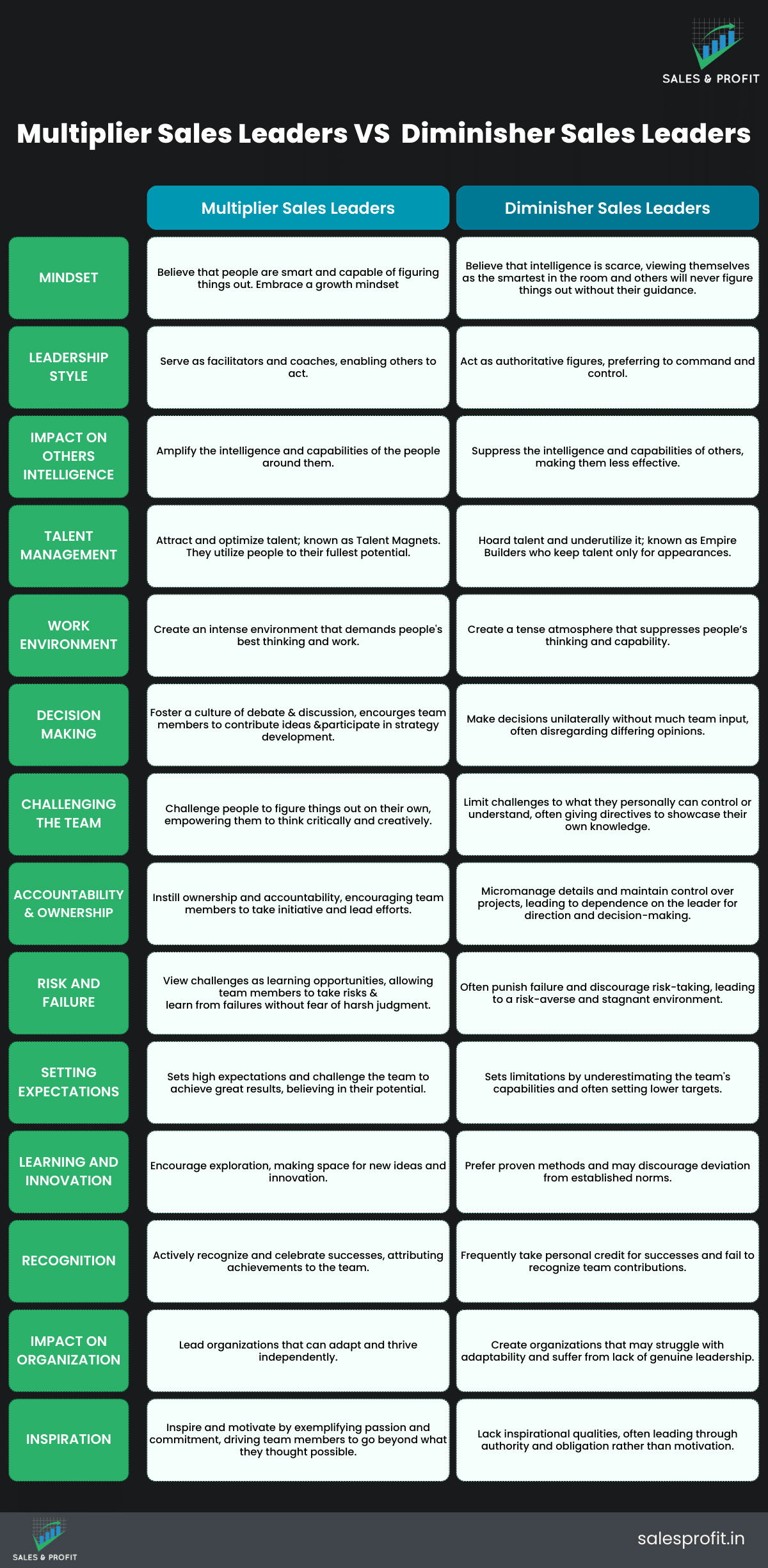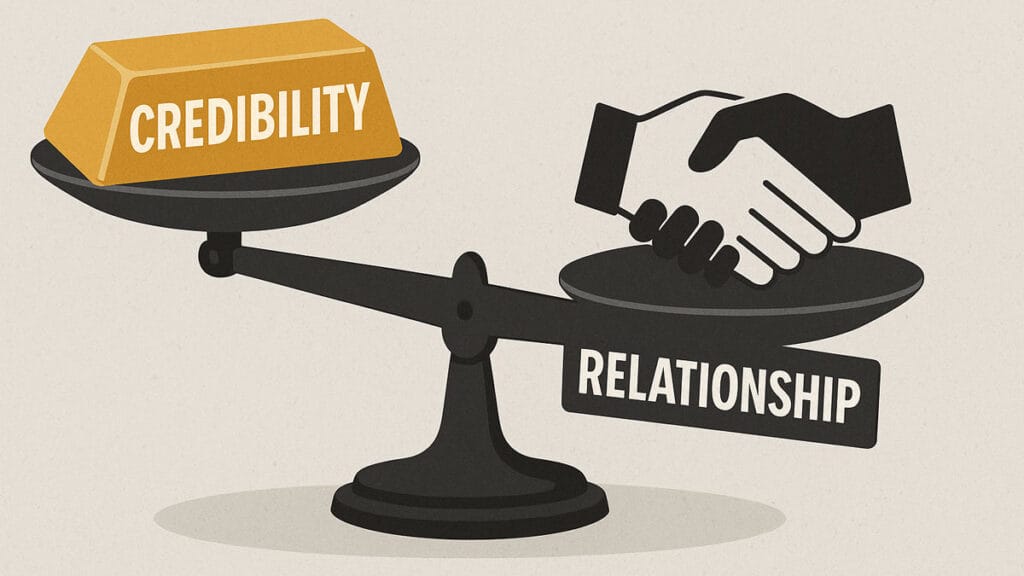Table of Contents
In Enterprise sales, leadership not only drives strategy but also the energy and effectiveness of the entire team.
Recently I read the book by “Multipliers” by Liz Wiseman’s,
The book introduces a profound concept where leaders are categorized into two groups: Multipliers leaders and Diminishers leaders.
I tried to observe the insights and applicability to “Sales Leaders”.
Before that, lets first understand the “Multipliers and Diminishers Effect”,
Wiseman describes Multipliers leaders uses their intelligence to amplify the smarts and capabilities of the people around them.
They inspire their teams to stretch themselves to deliver results that surpass expectations.
In contrast, Diminishers drain the intelligence and capability out of their teams, often needing to be the smartest person in the room, which stifles productivity and innovation.
Now let’s understand each of these leadership styles in detail.
Who are Multiplier Leaders?
Multiplier leaders are individuals who excel at amplifying the intelligence and capabilities of those around them, creating a culture of growth, innovation, and high performance within their organizations.
They are characterized by their ability to bring out the best in their teams and foster an environment where collective intelligence thrives.
Who are Diminisher Leaders?
Diminishers are a specific type of leader who, often unknowingly, suppress the intelligence and capabilities of their teams. While they may possess strong intelligence themselves, their leadership style tends to centralize authority and decision-making, which stifles the growth and effectiveness of their teams.
They are characterized by their tendency to dominate, control, and micromanage, stifling the growth and innovation of their teams
Difference Between Multiplier Sales Leaders and Diminisher Sales Leaders
(Click on the image to view it bigger)
Common Traits of Multiplier Leaders
1. Believes in continual development
Multipliers view intelligence as continually evolving, embracing a growth mindset where people are seen as capable of continuous improvement and growth.
2. Empowerment and trust
They trust in the intelligence and capabilities of their team members, believing that people are smart and can figure things out on their own.
Multipliers create an environment that liberates people’s best thinking and talents, allowing them to excel.
3. Develops talent
Instead of just using talent, Multipliers actively develop and nurture the talents of their team members, helping them reach their full potential and contribute at higher levels.
4. Approaches mistakes as opportunities
Multipliers see mistakes as opportunities for learning and growth.
They encourage exploration and learning from failures, fostering a culture of continuous improvement and innovation.
5. Decision-making style
Multipliers consult others in decision-making processes, valuing diverse perspectives and collective intelligence.
They believe in the power of collaboration and seek input from their team members.
Common Traits of Diminisher Leaders
1. Suppressing people's thinking and capability
Diminishers tend to limit the input and ideas of their team members, instead relying on their own knowledge and expertise.
2. Dominating the space
They often dominate meetings and conversations, leaving little room for others to contribute.
3. Creating anxiety
Diminishers can create a sense of uncertainty and anxiety among their team members, who may feel like they are walking on eggshells around the leader.
4. Judging others
Diminishers tend to centralize their power and play judge, jury, and executioner, rather than empowering their team members to take ownership and make decisions.
The Positive Impact of Multiplier Leaders
Research shows that Multipliers are highly effective leaders who can extract and extend the genius of others.
Multipliers utilize people at nearly 100 % of their capacity, meaning they get twice the capability from their people than Diminishers do, as individuals working with Multipliers offer their best thinking, creativity, and ideas, going above and beyond in their contributions
The Negative Impact of Diminisher Leaders
Diminishers can have a significant negative impact on their organizations, leading to underutilized talent, stifled creativity, and a lack of engagement among the sales team.
They often create a culture of fear, where people are hesitant to take risks or share their ideas, and instead focus on avoiding mistakes and pleasing the leader.
Do you want to enable your sales teams to become top performers?
Request a 100% free “no obligation” sales consulting call where we will understand more about your current sales team’s performance, where they are lacking and how to enable them .
(We have already enabled 100+ B2B sales professionals.)
How Multiplier Leaders Benefits an Organization
The positive impacts of Multiplier leaders not only enhance the internal workings of an organization but also contribute to its external competitiveness and reputation
Here are some positive impacts that Multiplier leaders typically have :
1. Promotes Innovation
Multipliers create a culture of curiosity and learning, encouraging team members to explore new ideas and solutions, which leads to increased innovation and creativity.
2. Increased Engagement of Team
By valuing and utilizing the intelligence of every team member, Multipliers enhance engagement, as employees feel their contributions are meaningful and valued.
3. Higher Productivity
Multipliers delegate responsibility and empower their teams to make decisions, which speeds up processes and enhances productivity.
4. Lower Turnover Rates
The supportive and empowering environment created by Multipliers leads to higher job satisfaction, which significantly reduces turnover rates.
5. Improved Team Morale
The inclusive and encouraging approach of Multipliers boosts team morale, leading to a more positive workplace atmosphere.
6. Accelerates Team's Personal & Professional Growth
Multipliers invest in the development of their teams, providing opportunities for learning and growth, which enhances career trajectories.
7. Open Communication
Multipliers promote open communication, ensuring clarity in direction and promoting a culture where all voices are heard and considered.
8. Encourags Risk-Taking
By instilling confidence and granting autonomy, Multipliers encourage calculated risk-taking, which can lead to breakthroughs and significant advancements.
9. Resource Optimization
Multipliers maximize the use of available resources by ensuring that all team members are operating at their highest potential, which improves efficiency.
10. Scalability
Organizations led by Multipliers often outperform their competitors because they leverage the collective intelligence of their workforce more effectively.
The Cost of Diminishers to an Organization
The cost of having Diminishers in an organization can be significant.
In fact, removing a Diminisher from a team can give back the equivalent of 5 full-time people, with 10 people operating at 100 percent
They can have an impact on various aspects of organization like :
1. Lack of Innovation
Employees may feel discouraged from presenting new ideas or solutions, leading to a lack of innovation and creative stagnation within the organization.
2. Reduced Employee Engagement
The controlling nature of Diminishers can lead to disengagement among team members who feel their contributions are undervalued or ignored.
3. Lower Productivity
Micromanagement and a lack of empowerment can result in decreased productivity as employees spend more time waiting for approvals or instructions rather than executing tasks independently.
4. Higher Turnover Rates
A diminished environment can lead to increased employee turnover. Talented individuals may seek more supportive and empowering workplaces.
5. Poor Team Morale
The oppressive atmosphere created by Diminishers can result in low morale, which can affect the overall work environment and lead to poor team cohesion.
6. Limited Personal and Professional Growth of Team
With a focus on maintaining control, Diminishers often fail to provide opportunities for their team members to develop new skills or advance their careers.
7. Impeded Communication:
The hierarchical and restrictive communication style preferred by Diminishers can lead to misunderstandings and lack of clear direction, affecting operational efficiency.
8. Resource Inefficiency:
By not fully utilizing the capabilities of their team, Diminishers fail to leverage existing resources effectively, which can lead to unnecessary overheads or missed efficiencies.
How to Transition from Diminisher to Multiplier Leader?

Transitioning from being a Diminisher to becoming a Multiplier is a transformative journey that involves shifting mindset, behaviours, and leadership practices.
Here are some steps help leaders make this transition effectively:
1. Recognize and Value Diverse Talent
Understand that intelligence and talent come in many forms.
Look beyond traditional credentials and recognize the unique skills each individual brings to the table.
Work closely with your team members to discover what activities they excel at naturally and find engaging.
This involves identifying their “flow” states—activities they are passionate about and perform effortlessly.
2. Allocate Roles Effectively
Assign roles and responsibilities that align with each person’s natural strengths.
Avoid misallocating talent, which can lead to frustration and inefficiency.
Ensure that team members are in positions where they can use their talents most effectively.
This not only enhances job satisfaction but also boosts overall team performance.
3. Believe in Your Talents
Recognize that intelligence is continually developing and that people are capable of growth and improvement.
Adopt the belief that everyone in the organization has untapped potential and can contribute at higher levels.
4. Develop Talent Instead of Using It
Shift from underutilizing talent to actively developing and nurturing the capabilities of team members.
Identify the unique strengths and native genius of individuals and provide opportunities for them to excel.
5. Avoid the Blame Game
Move away from blaming individuals for mistakes and instead foster a culture where failures are seen as opportunities for learning and growth.
Encourage team members to explore new ideas, take calculated risks, and learn from their experiences.
6. Challenge People to Figure Things Out
Set ambitious but achievable goals that stretch your team’s capabilities.
Provide the necessary support and resources to help them meet these challenges.
7. Consult Team Members in Decision-Making
Shift from making decisions for others to involving team members in the decision-making process.
Value diverse perspectives, seek input from others, and collaborate to make informed decisions.
8. Provide Specific Praise and Recognition
Regularly praise team members for their specific contributions and talents.
This not only boosts morale but also reinforces positive behaviors.
9. Support and Empower People
Move away from controlling individuals to creating an environment that liberates their best thinking.
Trust in the capabilities of team members, provide opportunities for growth, and remove barriers that hinder their success.
10. Encourage Experimentation and Learning
Encourage your team to experiment, take risks, and learn from their mistakes.
Create an environment where failures are seen as learning opportunities.
Give regular, constructive feedback that helps team members improve and grow without feeling criticized or undervalued.
11. Facilitate Open and Productive Debates
Create a culture where team members feel safe to share their ideas and opinions.
Encourage healthy debate and ensure all voices are heard.
Instead of giving directives, lead discussions with questions that prompt critical thinking and collaborative problem-solving.
12. Make Your Team Accountable
Clearly define who is responsible for what within the team. Ensure that everyone understands their role and the expectations associated with it.
Conduct regular check-ins to review progress, address any issues, and provide support.
This helps maintain momentum and keeps everyone aligned with the team’s goals.
13. Integrating Leadership Training for Sales Leaders
As leaders evolve into Multipliers, integrating specialized sales training can further enhance their leadership effectiveness.
An effective Sales training program can equip leaders with the skills to inspire and motivate their teams, driving sales performance and organizational success.
Explore how Sales & Profit’s sales training in India can complement your leadership team.






